2012 MERCEDES-BENZ SL ROADSTER snow chains
[x] Cancel search: snow chainsPage 205 of 637
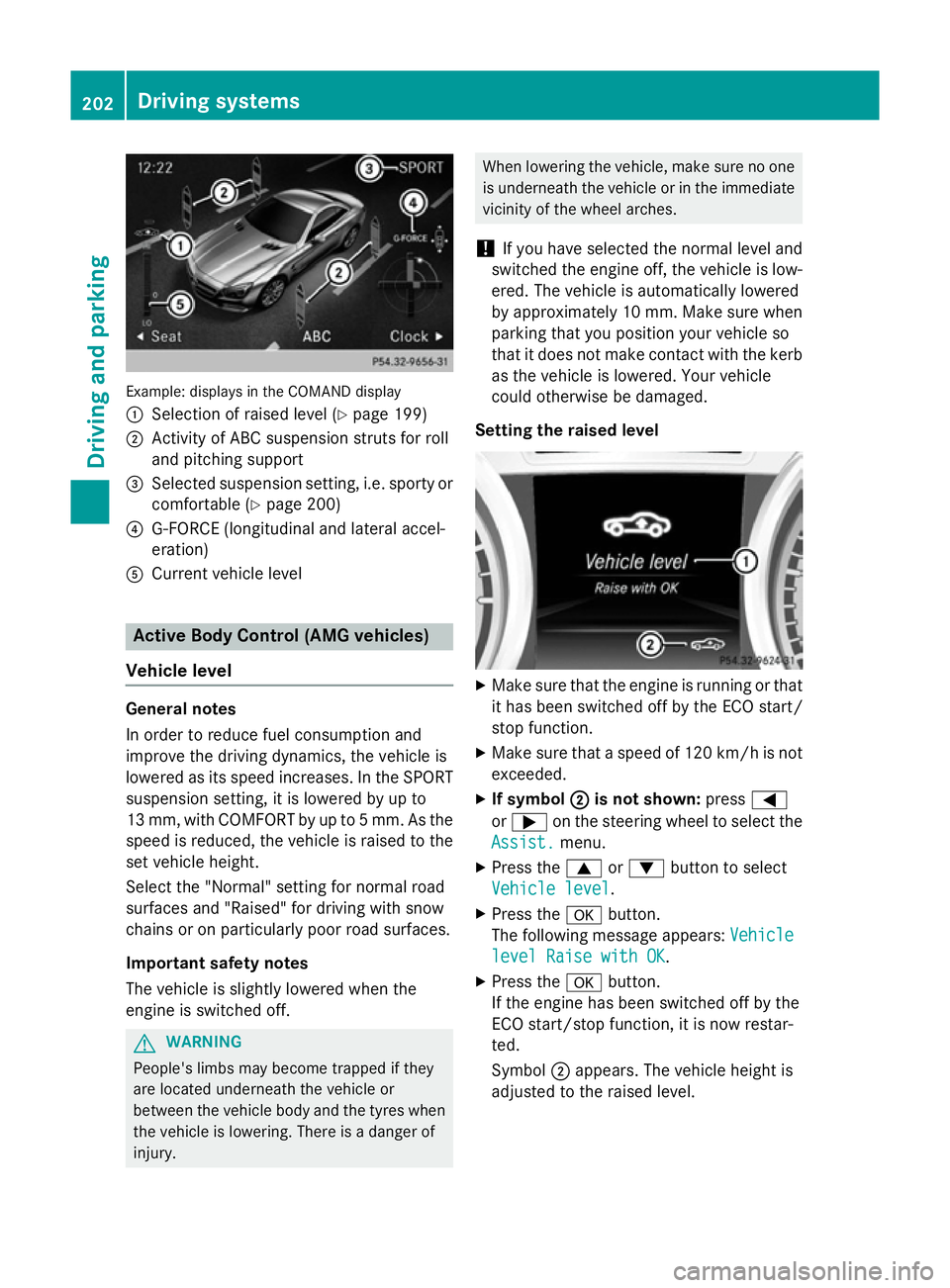
Example: displays in the COMAND display
: Selection of raised level (Y page 199)
; Activity of ABC suspension struts for roll
and pitching support
= Selected suspension setting, i.e. sporty or
comfortable (Y page 200)
? G-FORCE (longitudinal and lateral accel-
eration)
A Current vehicle level Active Body Control (AMG vehicles)
Vehicle level General notes
In order to reduce fuel consumption and
improve the driving dynamics, the vehicle is
lowered as its speed increases. In the SPORT
suspension setting, it is lowered by up to
13 mm, with COMFORT by up to 5 mm. As the
speed is reduced, the vehicle is raised to the set vehicle height.
Select the "Normal" setting for normal road
surfaces and "Raised" for driving with snow
chains or on particularly poor road surfaces.
Important safety notes
The vehicle is slightly lowered when the
engine is switched off. G
WARNING
People's limbs may become trapped if they
are located underneath the vehicle or
between the vehicle body and the tyres when the vehicle is lowering. There is a danger of
injury. When lowering the vehicle, make sure no one
is underneath the vehicle or in the immediate
vicinity of the wheel arches.
! If you have selected the normal level and
switched the engine off, the vehicle is low-
ered. The vehicle is automatically lowered
by approximately 10 mm. Make sure when
parking that you position your vehicle so
that it does not make contact with the kerb
as the vehicle is lowered. Your vehicle
could otherwise be damaged.
Setting the raised level X
Make sure that the engine is running or that
it has been switched off by the ECO start/
stop function.
X Make sure that a speed of 120 km/h is not
exceeded.
X If symbol ; ;is not shown: press=
or ; on the steering wheel to select the
Assist.
Assist. menu.
X Press the 9or: button to select
Vehicle level
Vehicle level.
X Press the abutton.
The following message appears: Vehicle
Vehicle
level Raise with OK
level Raise with OK.
X Press the abutton.
If the engine has been switched off by the
ECO start/stop function, it is now restar-
ted.
Symbol ;appears. The vehicle height is
adjusted to the raised level. 202
Driving systemsDriving an
d parking
Page 211 of 637
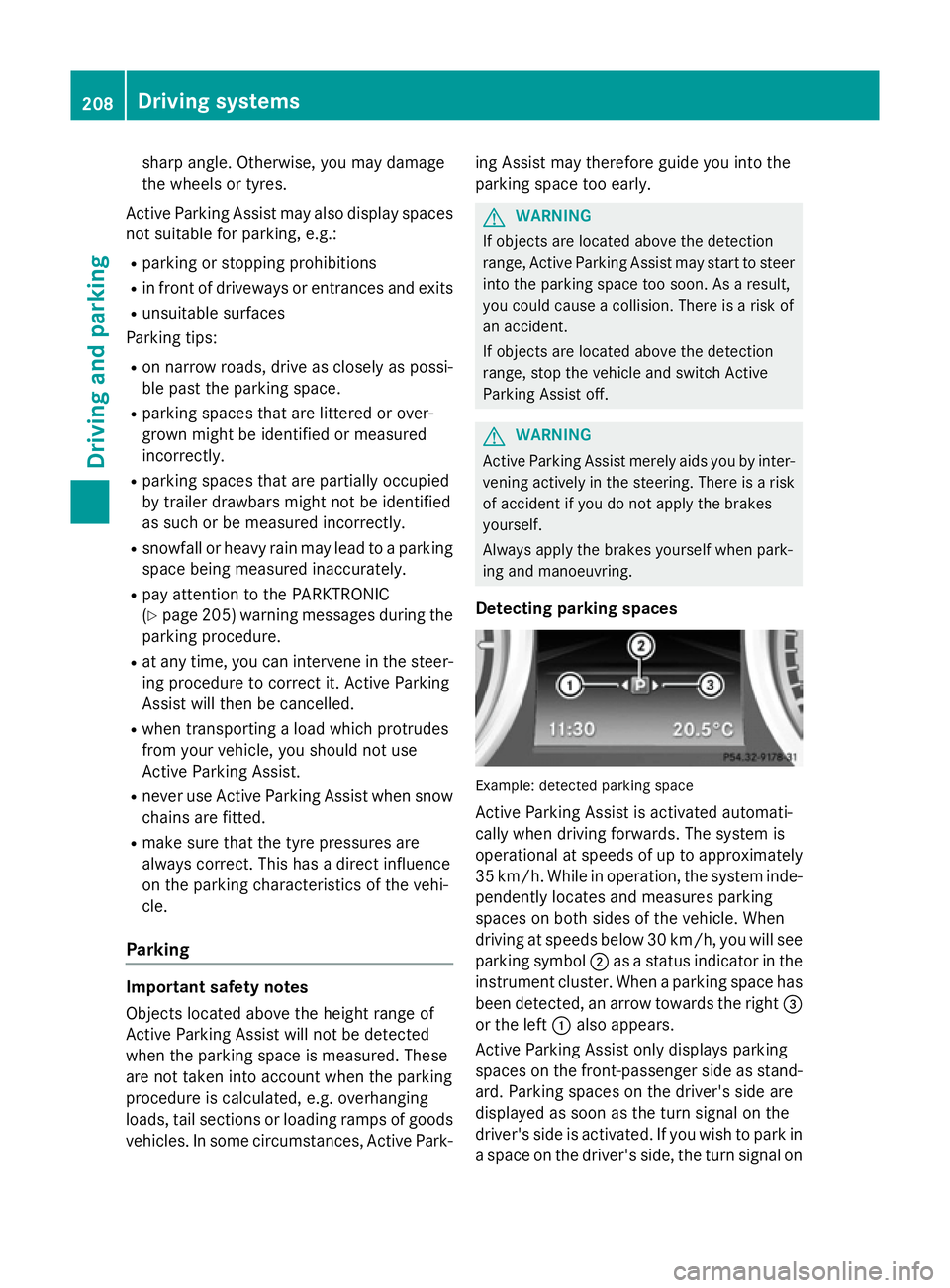
sharp angle. Otherwise, you may damage
the wheels or tyres.
Active Parking Assist may also display spaces not suitable for parking, e.g.:
R parking or stopping prohibitions
R in front of driveways or entrances and exits
R unsuitable surfaces
Parking tips:
R on narrow roads, drive as closely as possi-
ble past the parking space.
R parking spaces that are littered or over-
grown might be identified or measured
incorrectly.
R parking spaces that are partially occupied
by trailer drawbars might not be identified
as such or be measured incorrectly.
R snowfall or heavy rain may lead to a parking
space being measured inaccurately.
R pay attention to the PARKTRONIC
(Y page 205) warning messages during the
parking procedure.
R at any time, you can intervene in the steer-
ing procedure to correct it. Active Parking
Assist will then be cancelled.
R when transporting a load which protrudes
from your vehicle, you should not use
Active Parking Assist.
R never use Active Parking Assist when snow
chains are fitted.
R make sure that the tyre pressures are
always correct. This has a direct influence
on the parking characteristics of the vehi-
cle.
Parking Important safety notes
Objects located above the height range of
Active Parking Assist will not be detected
when the parking space is measured. These
are not taken into account when the parking
procedure is calculated, e.g. overhanging
loads, tail sections or loading ramps of goods vehicles. In some circumstances, Active Park- ing Assist may therefore guide you into the
parking space too early. G
WARNING
If objects are located above the detection
range, Active Parking Assist may start to steer into the parking space too soon. As a result,
you could cause a collision. There is a risk of
an accident.
If objects are located above the detection
range, stop the vehicle and switch Active
Parking Assist off. G
WARNING
Active Parking Assist merely aids you by inter- vening actively in the steering. There is a risk
of accident if you do not apply the brakes
yourself.
Always apply the brakes yourself when park-
ing and manoeuvring.
Detecting parking spaces Example: detected parking space
Active Parking Assist is activated automati-
cally when driving forwards. The system is
operational at speeds of up to approximately 35 km/h. While in operation, the system inde- pendently locates and measures parking
spaces on both sides of the vehicle. When
driving at speeds below 30 km/h, you will see
parking symbol ;as a status indicator in the
instrument cluster. When a parking space has
been detected, an arrow towards the right =
or the left :also appears.
Active Parking Assist only displays parking
spaces on the front-passenger side as stand- ard. Parking spaces on the driver's side are
displayed as soon as the turn signal on the
driver's side is activated. If you wish to park in
a space on the driver's side, the turn signal on 208
Driving systemsDriving and parking
Page 602 of 637
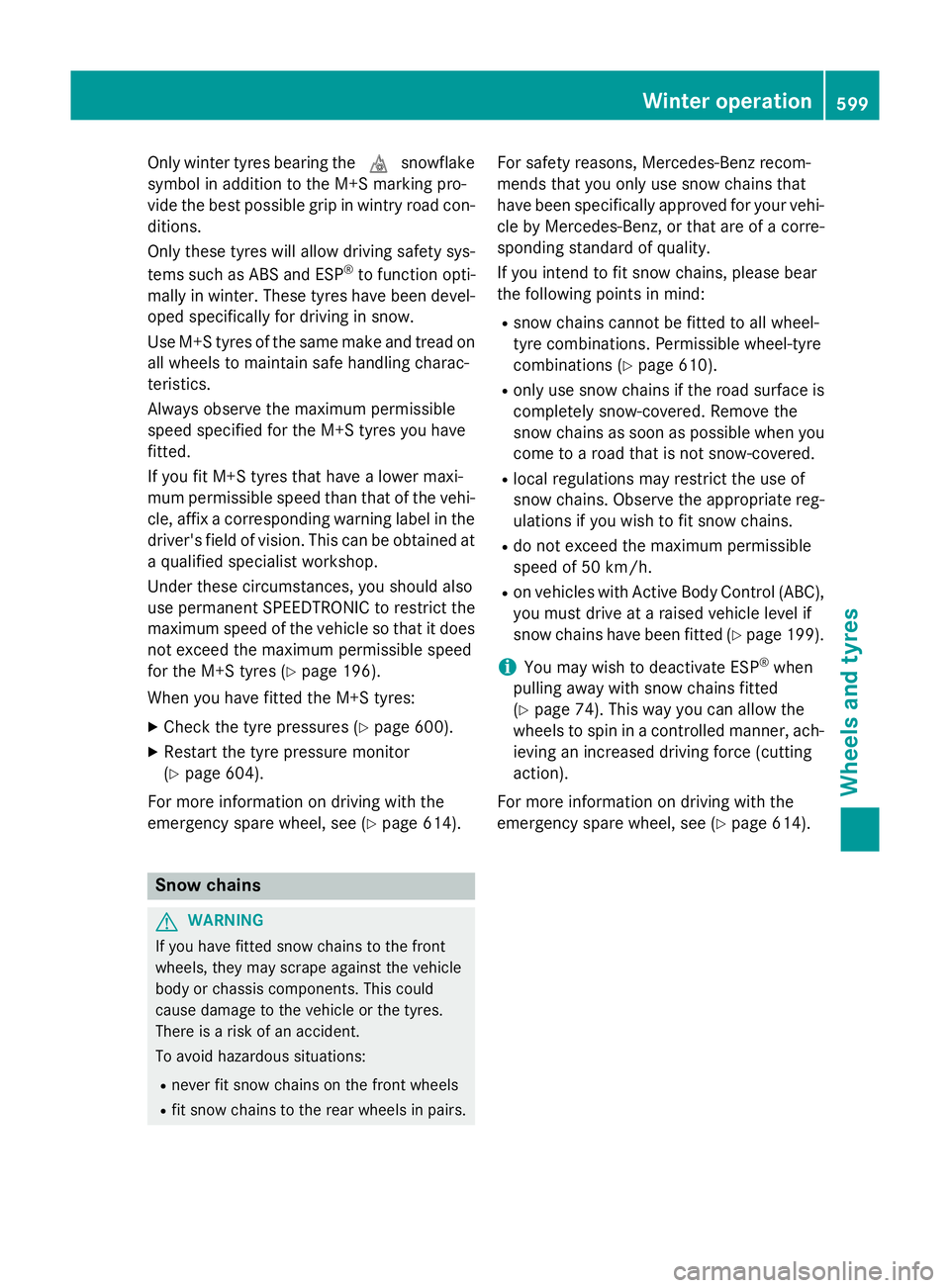
Only winter tyres bearing the
isnowflake
symbol in addition to the M+S marking pro-
vide the best possible grip in wintry road con- ditions.
Only these tyres will allow driving safety sys-
tems such as ABS and ESP ®
to function opti-
mally in winter. These tyres have been devel-
oped specifically for driving in snow.
Use M+S tyres of the same make and tread on
all wheels to maintain safe handling charac-
teristics.
Always observe the maximum permissible
speed specified for the M+S tyres you have
fitted.
If you fit M+S tyres that have a lower maxi-
mum permissible speed than that of the vehi-
cle, affix a corresponding warning label in the
driver's field of vision. This can be obtained at a qualified specialist workshop.
Under these circumstances, you should also
use permanent SPEEDTRONIC to restrict the
maximum speed of the vehicle so that it does not exceed the maximum permissible speed
for the M+S tyres (Y page 196).
When you have fitted the M+S tyres:
X Check the tyre pressures (Y page 600).
X Restart the tyre pressure monitor
(Y page 604).
For more information on driving with the
emergency spare wheel, see (Y page 614).Snow chains
G
WARNING
If you have fitted snow chains to the front
wheels, they may scrape against the vehicle
body or chassis components. This could
cause damage to the vehicle or the tyres.
There is a risk of an accident.
To avoid hazardous situations:
R never fit snow chains on the front wheels
R fit snow chains to the rear wheels in pairs. For safety reasons, Mercedes-Benz recom-
mends that you only use snow chains that
have been specifically approved for your vehi-
cle by Mercedes-Benz, or that are of a corre-
sponding standard of quality.
If you intend to fit snow chains, please bear
the following points in mind:
R snow chains cannot be fitted to all wheel-
tyre combinations. Permissible wheel-tyre
combinations (Y page 610).
R only use snow chains if the road surface is
completely snow-covered. Remove the
snow chains as soon as possible when you
come to a road that is not snow-covered.
R local regulations may restrict the use of
snow chains. Observe the appropriate reg-
ulations if you wish to fit snow chains.
R do not exceed the maximum permissible
speed of 50 km/h.
R on vehicles with Active Body Control (ABC),
you must drive at a raised vehicle level if
snow chains have been fitted (Y page 199).
i You may wish to deactivate ESP ®
when
pulling away with snow chains fitted
(Y page 74). This way you can allow the
wheels to spin in a controlled manner, ach-
ieving an increased driving force (cutting
action).
For more information on driving with the
emergency spare wheel, see (Y page 614). Winter operation
599Wheels and tyres Z
Page 604 of 637
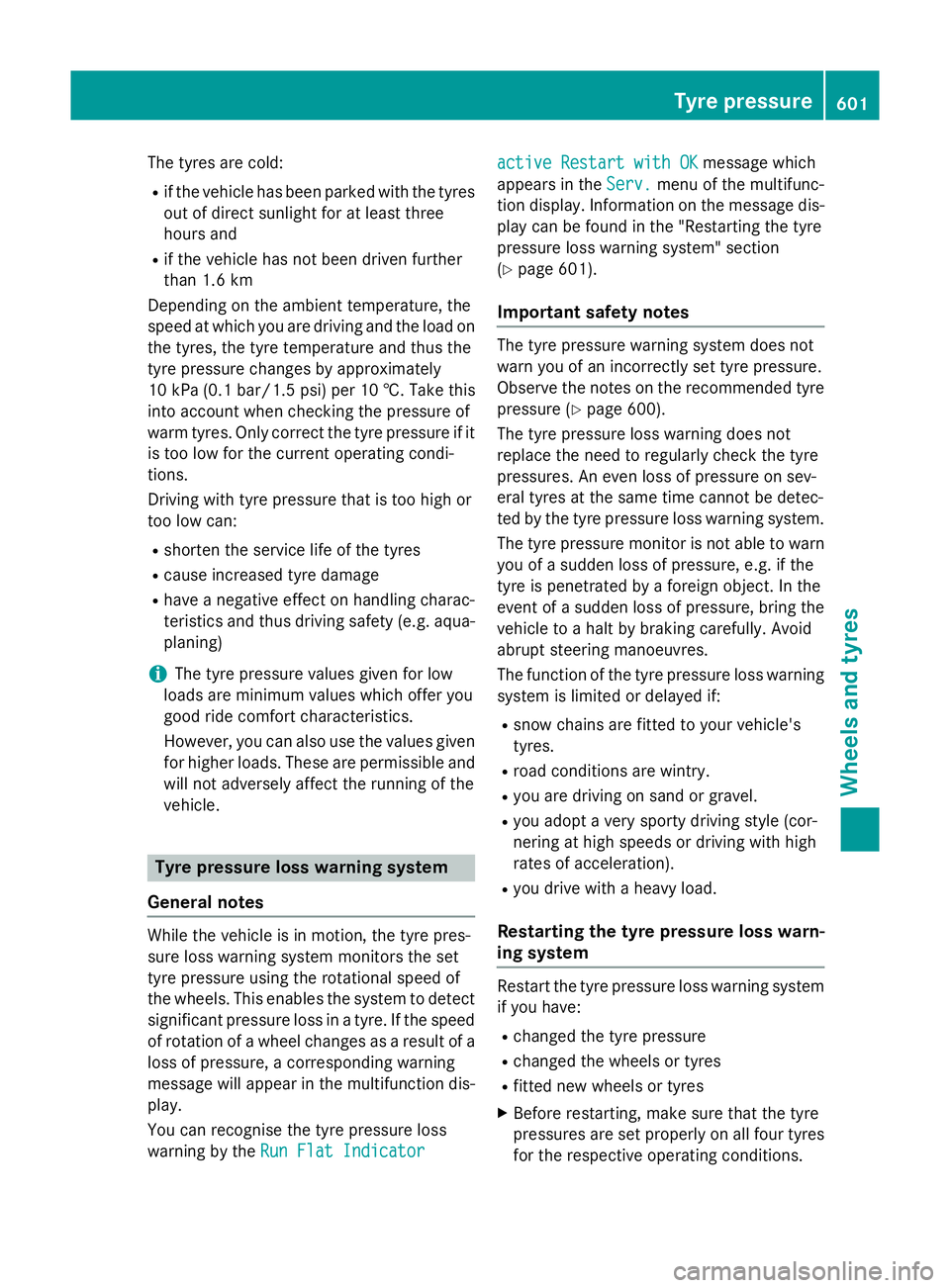
The tyres are cold:
R if the vehicle has been parked with the tyres
out of direct sunlight for at least three
hours and
R if the vehicle has not been driven further
than 1.6 km
Depending on the ambient temperature, the
speed at which you are driving and the load on the tyres, the tyre temperature and thus the
tyre pressure changes by approximately
10 kPa (0.1 bar/1.5 psi) per 10 †. Take this
into account when checking the pressure of
warm tyres. Only correct the tyre pressure if it
is too low for the current operating condi-
tions.
Driving with tyre pressure that is too high or
too low can:
R shorten the service life of the tyres
R cause increased tyre damage
R have a negative effect on handling charac-
teristics and thus driving safety (e.g. aqua- planing)
i The tyre pressure values given for low
loads are minimum values which offer you
good ride comfort characteristics.
However, you can also use the values given for higher loads. These are permissible andwill not adversely affect the running of the
vehicle. Tyre pressure loss warning system
General notes While the vehicle is in motion, the tyre pres-
sure loss warning system monitors the set
tyre pressure using the rotational speed of
the wheels. This enables the system to detect
significant pressure loss in a tyre. If the speed of rotation of a wheel changes as a result of aloss of pressure, a corresponding warning
message will appear in the multifunction dis-
play.
You can recognise the tyre pressure loss
warning by the Run Flat Indicator
Run Flat Indicator active Restart with OK active Restart with OK
message which
appears in the Serv.
Serv.menu of the multifunc-
tion display. Information on the message dis- play can be found in the "Restarting the tyre
pressure loss warning system" section
(Y page 601).
Important safety notes The tyre pressure warning system does not
warn you of an incorrectly set tyre pressure.
Observe the notes on the recommended tyre
pressure (Y page 600).
The tyre pressure loss warning does not
replace the need to regularly check the tyre
pressures. An even loss of pressure on sev-
eral tyres at the same time cannot be detec-
ted by the tyre pressure loss warning system.
The tyre pressure monitor is not able to warn you of a sudden loss of pressure, e.g. if the
tyre is penetrated by a foreign object. In the
event of a sudden loss of pressure, bring the
vehicle to a halt by braking carefully. Avoid
abrupt steering manoeuvres.
The function of the tyre pressure loss warning
system is limited or delayed if:
R snow chains are fitted to your vehicle's
tyres.
R road conditions are wintry.
R you are driving on sand or gravel.
R you adopt a very sporty driving style (cor-
nering at high speeds or driving with high
rates of acceleration).
R you drive with a heavy load.
Restarting the tyre pressure loss warn-
ing system Restart the tyre pressure loss warning system
if you have:
R changed the tyre pressure
R changed the wheels or tyres
R fitted new wheels or tyres
X Before restarting, make sure that the tyre
pressures are set properly on all four tyres
for the respective operating conditions. Tyre pressure
601Wheels and tyres Z
Page 615 of 637

Tyres
SL 350 Summer tyres
R17
Tyres Light-alloy wheels
BA: 255/4
5 R17 98 Y 1 BA: 8.0 J x 17 H2 ET 30
R18
Tyres Light-alloy wheels
BA: 255/40 R18 95 Y
1, 2 BA: 8.5 J x 18 H2 ET 35.5
FA: 255/40 R18 95 Y
2
RA: 285/35 R18 97 Y 2, 3 FA: 8.5 J x 18 H2 ET 35.5
RA: 9.5 J x 18 H2 ET 47.5
R19
Tyres Light-alloy wheels
FA: 255/35 R19 96 Y XL
2, 4
RA: 285/30 R19 98 Y XL 2, 3, 4 FA: 8.5 J x 19 H2 ET 35.5
RA: 9.5 J x 19 H2 ET 47.5
FA: 255/35 R19 96 Y XL
2, 4
RA: 285/30 R19 98 Y XL 2, 3, 4 FA: 8.5 J x 19 H2 ET 35.5
RA: 9.5 J x 19 H2 ET 48
Winter tyres
R17
Tyres Light-alloy wheels
BA: 255/45 R17 98 V M+S
i1 BA: 8.0 J x 17 H2 ET 30
R18
Tyres Light-alloy wheels
BA: 255/40 R18 99 V XL M+S
i2 BA: 8.5 J x 18 H2 ET 35.5
1
Not in conjunction with Active Body Control (Code 487), Sports package (Code 950) or Edition 1 package
(Code P88).
2 Available as MOExtended tyres.
3 The use of snow chains is not permitted. Observe the notes in the "Snow chains" section.
4 Observe notes on "Large wheels" in the "Wheel/tyre combinations" section. 612
Wheel and tyre combinationsWheels and tyres
Page 616 of 637
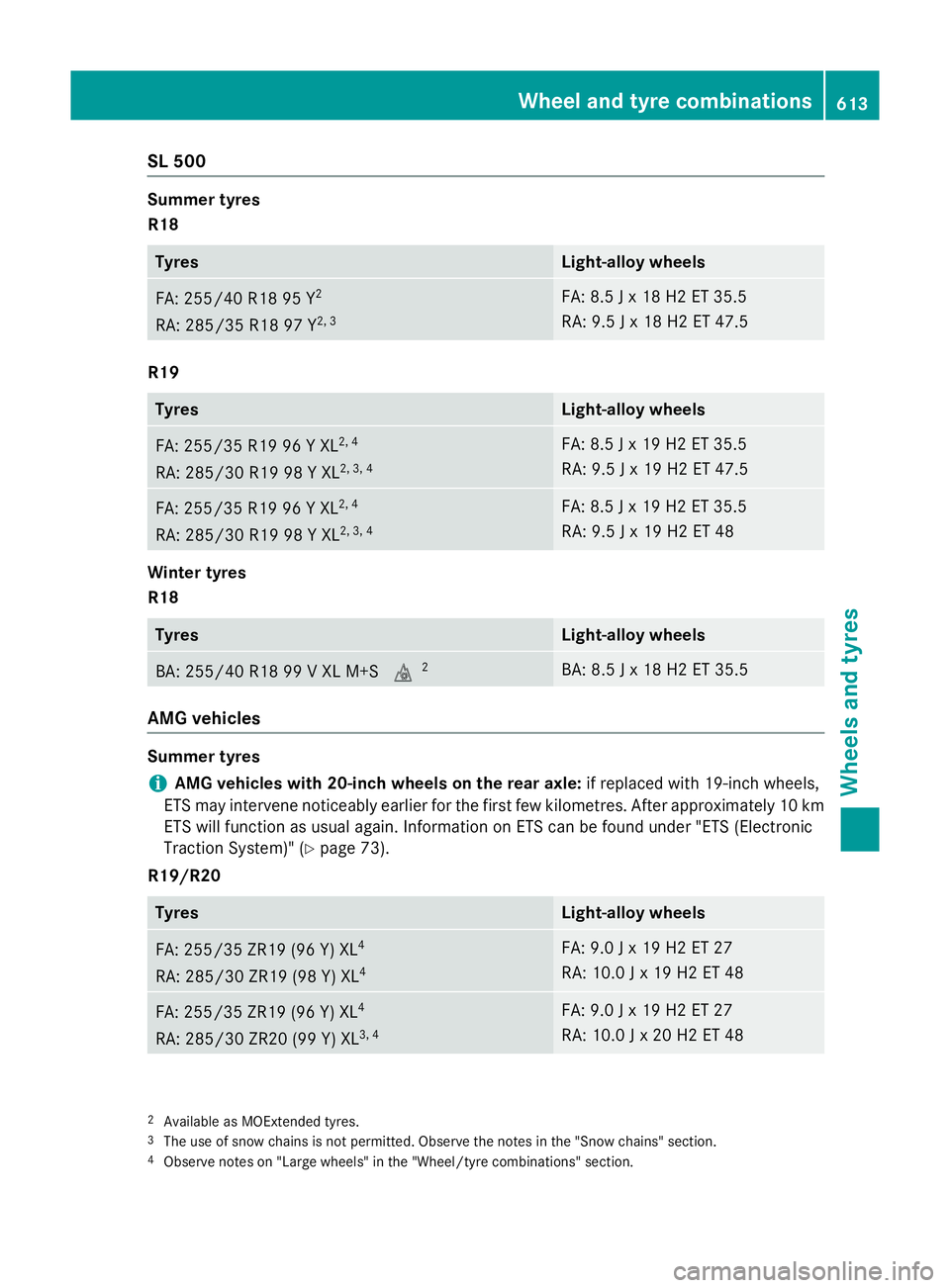
SL 500
Summer tyres
R18
Tyres Light-alloy wheels
FA: 255/40 R18 95 Y
2
RA: 285/35 R18 97 Y 2, 3 FA: 8.5 J x 18 H2 ET 35.5
RA: 9.5 J x 18 H2 ET 47.5
R19
Tyres Light-alloy wheels
FA: 255/35 R19 96 Y XL
2, 4
RA: 285/30 R19 98 Y XL 2, 3, 4 FA: 8.5 J x 19 H2 ET 35.5
RA: 9.5 J x 19 H2 ET 47.5
FA: 255/35 R19 96 Y XL
2, 4
RA: 285/30 R19 98 Y XL 2, 3, 4 FA: 8.5 J x 19 H2 ET 35.5
RA: 9.5 J x 19 H2 ET 48
Winter tyres
R18
Tyres Light-alloy wheels
BA: 255/40 R18 99 V XL M+S
i2 BA: 8.5 J x 18 H2 ET 35.5
AMG vehicles
Summer tyres
i AMG vehicles with 20-inch wheels on the rear axle:
if replaced with 19-inch wheels,
ETS may intervene noticeably earlier for the first few kilometres. After approximately 10 km ETS will function as usual again. Information on ETS can be found under "ETS (Electronic
Traction System)" (Y page 73).
R19/R20 Tyres Light-alloy wheels
FA: 255/35 ZR19 (96 Y) XL
4
RA: 285/30 ZR19 (98 Y) XL 4 FA: 9.0 J x 19 H2 ET 27
RA: 10.0 J x 19 H2 ET 48
FA: 255/35 ZR19 (96 Y) XL
4
RA: 285/30 ZR20 (99 Y) XL 3, 4 FA: 9.0 J x 19 H2 ET 27
RA: 10.0 J x 20 H2 ET 48
2
Available as MOExtended tyres.
3 The use of snow chains is not permitted. Observe the notes in the "Snow chains" section.
4 Observe notes on "Large wheels" in the "Wheel/tyre combinations" section. Wheel and tyre combinations
613Wheels and tyres Z
Page 617 of 637
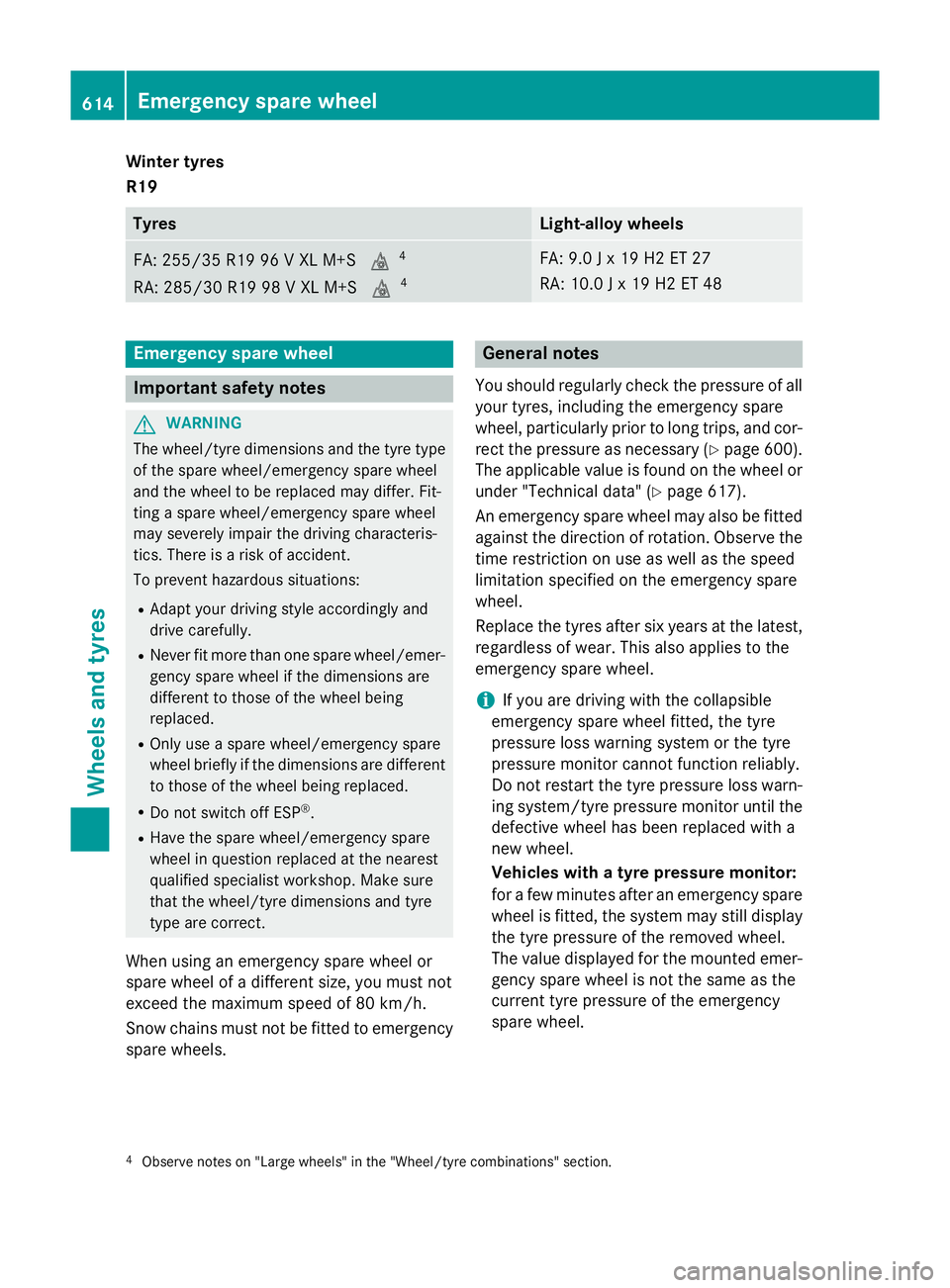
Winter tyres
R19
Tyres Light-alloy wheels
FA: 255/35 R19 96 V XL M+S
i4
RA: 285/30 R19 98 V XL M+S i4 FA: 9.0 J x 19 H2 ET 27
RA: 10.0 J x 19 H2 ET 48
Emergency spare wheel
Important safety notes
G
WARNING
The wheel/tyre dimensions and the tyre type of the spare wheel/emergency spare wheel
and the wheel to be replaced may differ. Fit-
ting a spare wheel/emergency spare wheel
may severely impair the driving characteris-
tics. There is a risk of accident.
To prevent hazardous situations:
R Adapt your driving style accordingly and
drive carefully.
R Never fit more than one spare wheel/emer-
gency spare wheel if the dimensions are
different to those of the wheel being
replaced.
R Only use a spare wheel/emergency spare
wheel briefly if the dimensions are different to those of the wheel being replaced.
R Do not switch off ESP ®
.
R Have the spare wheel/emergency spare
wheel in question replaced at the nearest
qualified specialist workshop. Make sure
that the wheel/tyre dimensions and tyre
type are correct.
When using an emergency spare wheel or
spare wheel of a different size, you must not
exceed the maximum speed of 80 km/h.
Snow chains must not be fitted to emergency
spare wheels. General notes
You should regularly check the pressure of all your tyres, including the emergency spare
wheel, particularly prior to long trips, and cor-
rect the pressure as necessary (Y page 600).
The applicable value is found on the wheel or
under "Technical data" (Y page 617).
An emergency spare wheel may also be fitted
against the direction of rotation. Observe the time restriction on use as well as the speed
limitation specified on the emergency spare
wheel.
Replace the tyres after six years at the latest,
regardless of wear. This also applies to the
emergency spare wheel.
i If you are driving with the collapsible
emergency spare wheel fitted, the tyre
pressure loss warning system or the tyre
pressure monitor cannot function reliably.
Do not restart the tyre pressure loss warn-
ing system/tyre pressure monitor until the
defective wheel has been replaced with a
new wheel.
Vehicles with a tyre pressure monitor:
for a few minutes after an emergency spare wheel is fitted, the system may still display
the tyre pressure of the removed wheel.
The value displayed for the mounted emer-
gency spare wheel is not the same as the
current tyre pressure of the emergency
spare wheel.
4 Observe notes on "Large wheels" in the "Wheel/tyre combinations" section. 614
Emergency spare wheelWheels and tyres